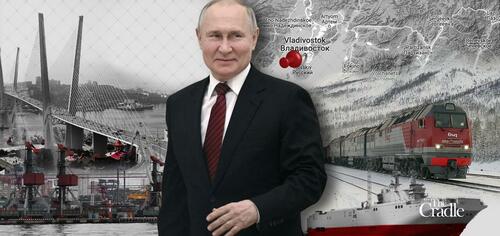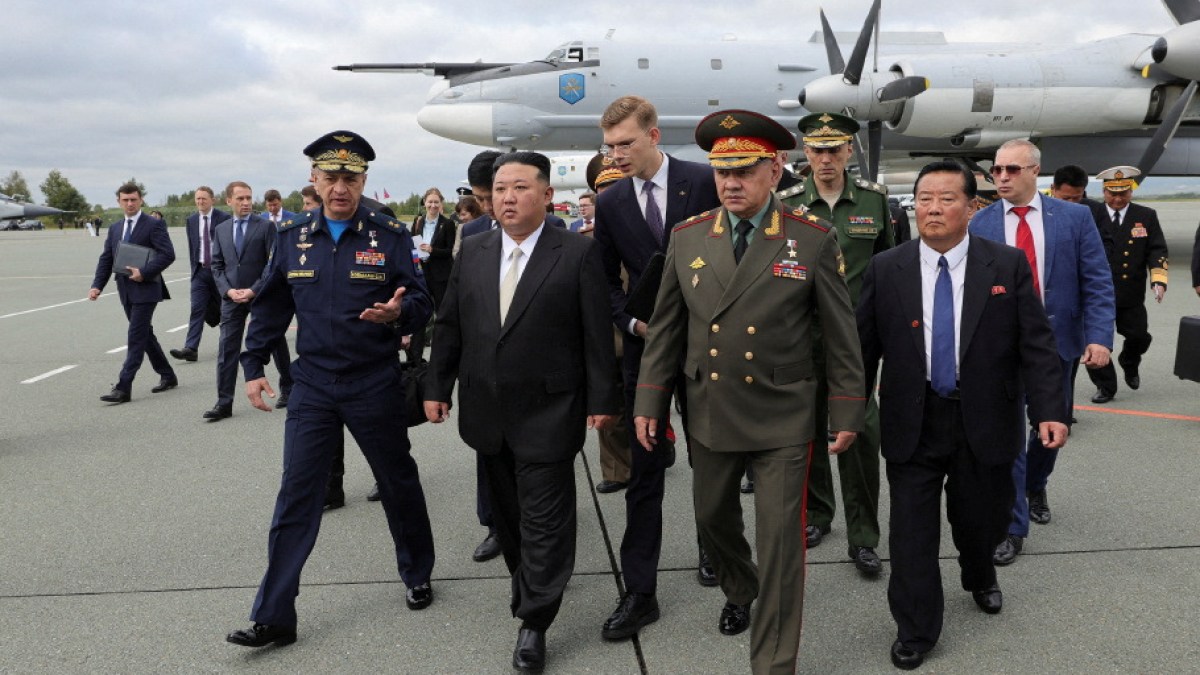Authored by Pepe Escobar via The Cradle,
In Vladivostok, the Russian Far East rises
In Vladivostok this week, the ‘Russian Far East’ was on full, glorious display. Russia, China, India, and the Global South were all there to contribute to this trade, investment, infrastructure, transportation, and institutional renaissance.

Russian President Vladimir Putin opened and closed his quite detailed address to the Eastern Economic Forum in Vladivostok with a resounding message: “The Far East is Russia’s strategic priority for the entire 21st century.”
And that’s exactly the feeling one would have prior to the address, interacting with business executives mingling across the stunning forum grounds at the Far Eastern Federal University (opened only 11 years ago), with the backdrop of the more than four kilometer-long suspension bridge to Russky Island across the Eastern Bosphorus strait.
The development possibilities of what is in effect Russian Asia, and one of the key nodes of Asia-Pacific, are literally mind-boggling. Data from the Ministry for the Development of the Russian Far East and the Arctic – confirmed by several of the most eye-catching panels during the Forum – list a whopping 2,800 investment projects underway, 646 of which are already up and running, complete with the creation of several international Advanced Special Economic Zones (ASEZ) and the expansion of the Free Port of Vladivostok, home to several hundred small and midsize enterprises (SMEs).
All that goes way beyond Russia’s “pivot to the East” which was announced by Putin in 2012, two years before the Maidan events in Kiev. For the rest of the planet, not to mention the collective west, it is impossible to understand the Russian Far East magic without being on the spot – starting with Vladivostok, the charming, unofficial capital of the Far East, with its gorgeous hills, striking architecture, verdant islands, sandy bays and of course the terminal of the legendary Trans-Siberian Railway.
What Global South visitors did experience – the collective west was virtually absent from the Forum – was a work in progress in sustainable development: a sovereign state setting the tone in terms of integrating large swathes of its territory to the new, emerging, polycentric geoeconomic era. Delegations from ASEAN (Laos, Myanmar, Philippines) and the Arab world, not to mention India and China, totally understood the picture.
Welcome to the ‘de-westernization movement’
In his speech, Putin stressed how the rate of investment in the Far East is three times the Russian region average; how the Far East is only 35 percent explored, with unlimited potential for natural resource industries; how the Power of Siberia and Sakhalin-Khabarovsk-Vladivostok gas pipelines will be connected; and how by 2030, liquified natural gas (LNG) production in the Russian Arctic will triple.
In a broader context, Putin made clear that “the global economy has changed and continues to change; the west, with its own hands, is destroying the system of trade and finance that it itself created.” It is no wonder then that Russia’s trade turnover with Asia-Pacific grew by 13.7 percent in 2022, and by another 18.3 percent in just the first half of 2023.
Cue to Presidential Business Rights Commissioner Boris Titov showing how this reorientation away from the “static” west is inevitable. Although western economies are well-developed, they are already “too heavily invested and sluggish,” says Titov:
“In the East, on the other hand, everything is booming, moving forward rapidly, developing rapidly. And this applies not only to China, India, and Indonesia, but also to many other countries. They are the center of development today, not Europe, our main consumers of energy are there, finally.”
It is quite impossible to do justice to the enormous scope and absorbing discussions featured in the major panels in Vladivostok. Here is just a taste of the key themes.
A Valdai session focused on the accumulated positive effects of Russia’s “pivot to the East,” with the Far East positioned as the natural hub for swinging the entire Russian economy to Asian geoeconomics.
Yet there are problems, of course, as stressed by Wang Wen from the Chongyang Institute for Financial Studies at Renmin University. Vladivostok’s population is only 600,000. the Chinese would say that for such a city, infrastructure is poor, “so it needs more infrastructure as fast as it can. Vladivostok could become the next Hong Kong. The way is to set up SEZs like in Hong Kong, Shenzhen and Pudong.” Not hard, as “the non-western world very much welcomes Russia.”
Wang Wen could not but highlight the breakthrough represented by the Huawei Mate 60 Pro: “Sanctions are not such a bad thing. They only strengthen the “de-westernization movement,” as it is informally referred to in China.
China by mid-2022 slipped into was defined by Wang as “silent mode” in terms of investment for fear of US secondary sanctions. But now that’s changing, and frontier regions once again are regarded as key to trade ties. In the Free Port of Vladivostok, China is the number one investor with its $11 billion commitment.
Fesco is the largest maritime transportation company in Russia – and reaches China, Japan, Korea and Vietnam. They are actively engaged in the connection of Southeast Asia to the Northern Sea Route, in cooperation with Russian Railways. The key is to set up a network of logistic hubs. Fesco executives describe it as “titanic shift in logistics.”
Russian Railways in itself is a fascinating case. It operates, among others, the Trans-Baikal, which happens to be the world’s busiest rail line, connecting Russia from the Urals to the Far East. Chita, smack on the Trans-Siberian – a top manufacturing center 900 km east of Irkutsk – is considered the capital of Russian Railways.
And then there’s the Arctic. The Arctic is home to 80 percent of Russia’s gas, 20 percent of its oil, 30 percent of its territory, 15 percent of GDP, but consists of only 2.5 million people. The development of the Northern Sea Route requires top-notch high-tech, such as a constantly evolving feet of icebreakers.
Liquid and stable as vodka
All that transpired in Vladivostok connects directly to the much-ballyhooed visit by North Korea’s Kim Jong-un. The timing was a beauty; after all the Primorsky Krai region in the Far East is an immediate neighbor to the Democratic People’s Republic of Korea (DPRK).
Putin emphasized that Russia and the DPRK are developing several joint projects in transportation, communications, logistics, and naval sectors.
So much more than military and space matters amicably discussed by Putin and Kim, the heart of the matter is geoeconomics: a trilateral Russia-China-DPRK cooperation, with the distinct outcome of increased container traffic transiting through the DPRK and the tantalizing possibility of DPRK rail reaching Vladivostok and then connecting deeper into Eurasia via the Trans-Siberian line.
And if that was not ground-breaking enough, much was discussed in several round tables about the International North South Transportation Corridor (INTSC). The Russia-Kazakhstan-Turkmenistan-Iran corridor will be finalized in 2027 – and that will be a key branch of the INTSC.
In parallel, New Delhi and Moscow are itching to start the Eastern Maritime Corridor (EMC) as soon as possible – that’s the official denomination of the Vladivostok-Chennai route. Sarbananda Sonowal, the Indian minister of ports, shipping and waterways, promoted an Indo-Russian workshop on the EMC in Chennai from October 30 to discuss “the smooth and swift operationalization” of the corridor.
I had the honor of being part of one of the crucial panels, Greater Eurasia: Drivers for the Formation of an Alternative International Monetary and Financial System.
A key conclusion is that the stage is set for a common Eurasia payment system – part of the Eurasian Economic Union’s (EAEU) draft declaration for 2030-2045 – against the backdrop of Hybrid War and “toxic currencies” (83 per cent of EAEU transactions already bypass them).
Yet the debate remains fierce when it comes to a basket of national currencies, a basket of goods, payment and settlement structures, the use of blockchain, a new pricing system, or setting up a single stock exchange. Is it all possible, technically? Yes, but that would take 30 or 40 years to take shape, as the panel stressed.
As it stands, a single example of challenges ahead is enough. The idea of coming up with a basket of currencies for an alternative payment system did not gather steam at the BRICS summit because of India’s position.
Aleksandr Babakov, deputy chairman of the Duma, evoked the discussions between the Shanghai Cooperation Organization (SCO) and Iran on trade financing in national currencies, including a road map to look for best ways in legislation to help attract investment. That’s also being discussed with private companies. The model is the success of the China-Russia trade turnover.
Andrey Klepach, chief economist at VEB, quipped that the best currency is “liquid and stable. Like vodka.” So we’re not there yet. Two-thirds of trade are still carried in dollars and euros; the Chinese yuan accounts for only three percent. India refuses to use the yuan. And there’s a huge Russia-India imbalance: as much as 40 billion rupees are sitting in Russian exporters accounts with nowhere to go. A priority is to improve trust in the ruble: it should be accepted by both India and China. And a digital ruble is becoming a necessity.
Wang Wen concurred, saying there’s not enough ambition. India should export more to Russia and Russia should invest more in India.
In parallel, as pointed out by Sohail Khan, the deputy secretary-general of the SCO, India now controls no less than 40 percent of the global digital payment market. It had a share of zero only seven years ago. That accounts for the success of its unified payment system (UPI).
A BRICS-EAEU panel expressed the hope that a joint summit of these two key multilateral organizations will happen next year. Once again, it’s all about trans-Eurasian transportation corridors – as two-thirds of world turnover will soon follow the eastern track connecting Russia to Asia.
On BRICS-EAEU-SCO, top Russian companies are already integrated into BRICS business, from Russian Railways and Rostec to big banks. A big problem remains how to explain the EAEU to India – even as the EAEU structure is deemed to be a success. And watch this space: a free trade agreement with Iran will be clinched soon.
At the last panel in Vladivostok, Russian Foreign Ministry Spokeswoman Maria Zakharova – the contemporary counterpart of Hermes, the messenger of the Gods – pointed out how the G20 and BRICS summits set the stage for Putin’s speech at the Eastern Economic Forum.
That required “fantastic strategic patience.”
Russia, after all, “never supported isolation” and “always advocated partnership.” The frantic activity in Vladivostok has just demonstrated how the “pivot to Asia” is all about enhanced connectivity and partnership in a new polycentric era.















